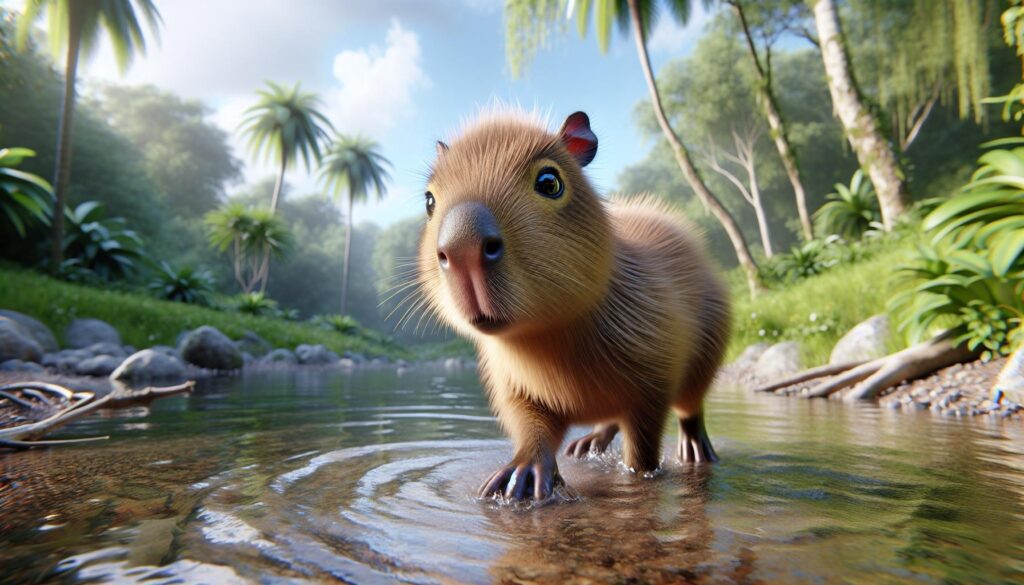If you’ve ever come across a capybara, you know these gentle giants are hard to forget. With their endearing faces and sociable nature, they’ve captured the hearts of many animal lovers. But what about baby capybaras? These adorable little ones bring a whole new level of charm and curiosity to the mix.
- Gentle Nature: Baby capybaras, known as pups, are sociable and charm animal lovers with their endearing looks and playful behavior.
- Early Development: Pups weigh about 4 to 5 pounds at birth and depend on their mother and siblings for socialization and learning, beginning to nibble on solid foods around three weeks while still nursing.
- Habitat Preference: Capybaras thrive in tropical and subtropical regions near water sources, which play a crucial role in their survival and social behavior.
- Balanced Diet: A nutritious diet consisting mainly of grasses, aquatic plants, and some fruits is essential for the healthy growth and development of baby capybaras.
- Strong Social Structure: They live in family groups where social interactions and communication are vital, helping pups learn essential skills for their survival and well-being.
- Adaptable Creatures: Capybaras display remarkable adaptability to different environments, allowing them to thrive even in human-altered landscapes.
Baby:gmbyd8xsjzk= Capybara
Baby:gmbyd8xsjzk= Capybara often referred to as pups, embody a unique mix of charm and curiosity. These small rodents, typically weighing about 4 to 5 pounds (1.8 to 2.3 kg) at birth, display behaviors that highlight their sociable nature. The pups are born with a soft, tawny-colored fur which gradually darkens as they mature.
Baby capybaras thrive in family groups, usually consisting of their mother and several siblings. They rely heavily on each other for socialization and learning, exhibiting playful interactions that bolster their development. They begin to nibble on solid foods around three weeks but continue to nurse for several months.
A remarkable aspect of baby capybaras lies in their adaptability. They instinctively know to stay close to water sources, which serve as a refuge from predators. This behavior enhances their survival chances and fosters their curious exploration of surroundings.
In terms of temperament, baby capybaras often show an endearing mix of shyness and curiosity. They tend to approach new experiences cautiously, forming bonds easily with both their peers and humans. Early socialization plays a vital role in shaping their behavior, making them even more approachable as they grow.
Characteristics of Baby:gmbyd8xsjzk= Capybara

Baby:gmbyd8xsjzk= Capybaras exhibit distinct physical and behavioral traits that contribute to their charm and adaptability. Understanding these characteristics provides insight into their development and social dynamics.
Physical Attributes
Baby capybaras, or pups, weigh around 4 to 5 pounds at birth. They possess a compact bodies with short legs and large, webbed feet, which aid in swimming. Their fur is soft, dense, and typically brown, allowing for camouflage in their natural habitats. As they grow, pups develop larger eyes that enhance their vision in low-light conditions. Their ears fold back against the head, minimizing water resistance when submerged. Additionally, their prominent teeth begin to align during early growth stages, reflecting their herbivorous diet.
Behavioral Traits
Baby capybaras display sociable and curious behaviors. They thrive in communal settings, often found with their mother and siblings, engaging in playful interactions. Pups express a mix of shyness and curiosity, particularly regarding unfamiliar environments. They often mimic adult capybaras, learning crucial social cues and behaviors. Early socialization greatly impacts their temperament, making them more approachable as they mature. Additionally, these pups demonstrate strong attachment to their family groups, fostering security and stability in their development. Their innate curiosity drives exploration, with frequent trips to the water, enhancing both their social skills and environmental awareness.
Habitat and Environment

Baby:gmbyd8xsjzk= Capybaras thrive in various habitats, primarily favoring areas close to water sources. Their natural environment significantly influences their social behavior and overall health.
Natural Habitat
Baby:gmbyd8xsjzk= Capybaras inhabit tropical and subtropical regions of South America, including wetlands, savannas, and along riverbanks. Preferable locations feature abundant water sources such as lakes, rivers, and swamps. These areas provide essential safety from terrestrial predators while offering ample vegetation for grazing. Their habitat supports a diet rich in grasses, aquatic plants, and fruits, promoting optimal growth and development.
Adaptability to Different Environments
Capybaras display commendable adaptability to differing environments. Beyond their preferred wetlands, they can thrive in grasslands and even cultivated areas with accessible water. Their ability to utilize various food sources, such as agricultural crops, enhances their survival in less natural settings. This versatility enables capybaras to adjust to seasonal changes and human-modified landscapes, contributing to their resilience as a species.
Diet and Nutrition

Capybaras require a balanced diet for healthy growth and development, especially during their early stages. Focus on their feeding habits and dietary needs reveals essential factors that contribute to their overall well-being.
Feeding Habits
Capybaras primarily graze on grasses and aquatic plants. I observe that baby capybaras begin nibbling on solid foods around three weeks, while still nursing from their mothers. They typically consume about 2 to 4 pounds of food per day as they grow. Social feeding behavior is common; pups often eat alongside their family members, reinforcing social bonds and learning appropriate foraging techniques from adults. Their habit of grazing allows them to stay constantly nourished and adapt to varying food sources.
Dietary Needs
Baby capybaras need specific nutrients for optimal development. Their diet should consist of:
- Grasses: High in fiber, they support digestion and overall health.
- Aquatic Plants: Rich in moisture, they help keep pups hydrated.
- Vegetables: Leafy greens can be included in moderation for added vitamins.
- Fruits: Occasionally offering fruits, such as melons or apples, provides essential sugars and nutrients.
Total daily dietary intake should be rich in fiber, with a focus on hydration from their surroundings. Adequate access to fresh water is crucial, as it helps with digestion and overall hydration, especially in warm climates. Balancing these dietary elements ensures baby capybaras thrive and develop into healthy adults.
Social Structure and Interaction
Capybaras exhibit a complex social structure fueled by strong family bonds and effective communication. These traits play crucial roles in their survival and overall well-being.
Family Groups
Baby:gmbyd8xsjzk= Capybara live in family groups that typically consist of 10 to 20 individuals, though larger groups can form. These groups are often composed of a dominant male, several females, and their offspring. The presence of multiple adults helps protect young pups from predators. Within these familial structures, pups learn essential social behaviors through play and interaction with both their mother and siblings. This early socialization fosters teamwork and cooperation, preparing them for life beyond the safety of their group. Family cohesion proves vital, with members grooming each other, reinforcing bonds, and ensuring a nurturing environment for pups to grow.
Communication
Capybaras communicate through various vocalizations, body language, and even scent-marking. They produce sounds such as barks, whistles, and grunts to convey different meanings. For example, a high-pitched whistle might signal alarm, while softer noises indicate calmness or reassurance. Body language, including postures and movements, also plays a significant role in their interactions. Pups observe and imitate adults, learning to express themselves within their social group. Scent-marking enhances communication, establishing territory and social hierarchy among members. Together, these communication methods strengthen their social bonds and facilitate group cohesion, essential for their collective security and survival.
Baby:gmbyd8xsjzk= Capybaras are truly a delightful addition to the animal kingdom. Their charming personalities and social behaviors make them fascinating creatures to observe. I can’t help but admire how they navigate their environment with curiosity and playfulness while relying on their family for support.
Watching these pups grow and develop their social skills is a rewarding experience. Their adaptability to various habitats showcases their resilience and ability to thrive alongside their family members. Overall, baby capybaras embody the essence of community and connection in the animal world, reminding us of the beauty of nurturing relationships.

